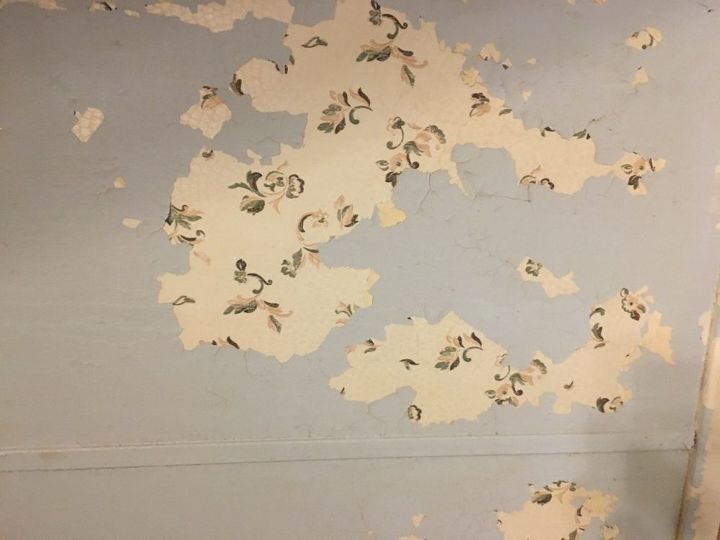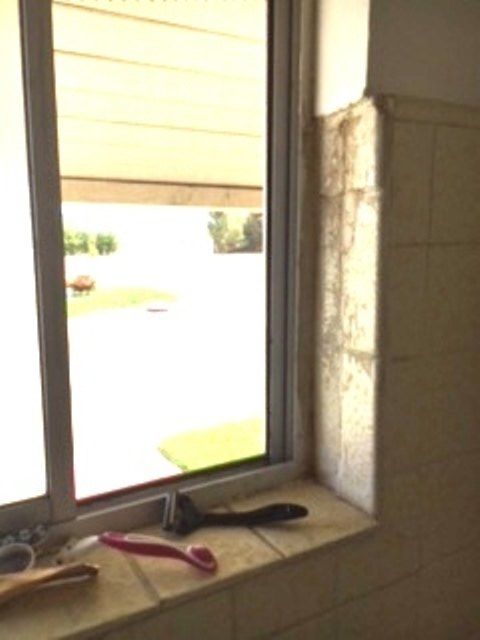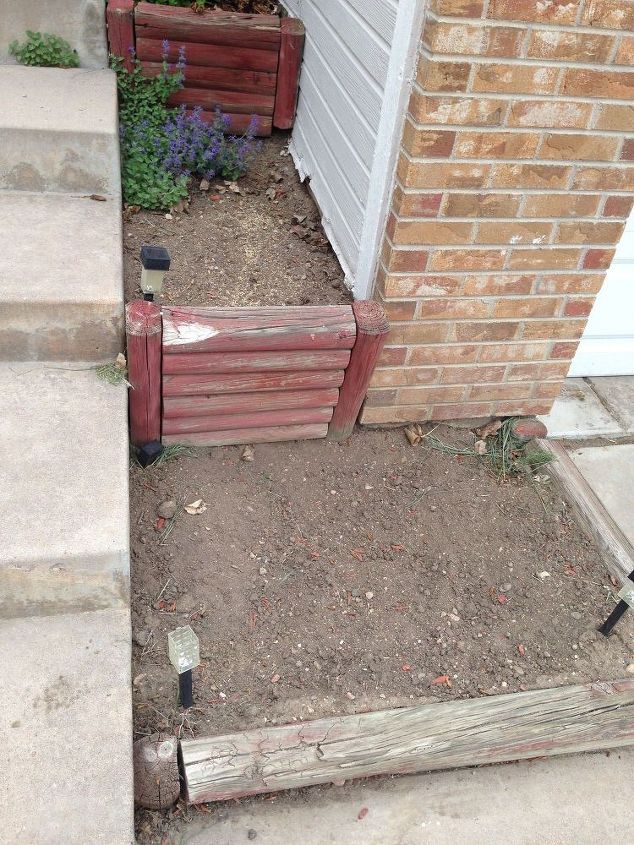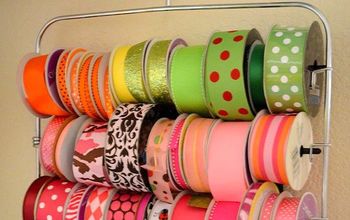This is worst part of the shower walls . The rest of it just has very small pieces missing.
How to fix shower wall on a budget? Help!

.....my shower wall?
I have a manufactured home and I cleaned with Clorox and alcohol and primed with Oil based Kilz then used a latex BEHR paint. It’s only been a year.
My paint just recently ( about a month or so ) started peeling.
I only have about less than $100 dollars to repair this and I’m the only one able to do it so I need some really budget friendly suggestions!
I have some tin but I don’t think I’m strong enough to cut to fit.
Thanks in advance!
Related Discussions
How to get rid of mice?
We seem to have some unwelcome Mickeys and Minnies in our house. What is the best way to get rid of them?
How to remove popcorn ceiling with asbestos?
I want to remove my popcorn ceiling, but it has asbestos in it. How do I go about this safely?
How to caulk baseboard gaps?
How do I fill gaps at baseboard, should I caulk? If so, does anyone know how to caulk baseboards?
How to fix squeaky hardwood floors?
How do I fix squeaky hardwood floors?
I'm a renter - how to FIX cracked bath/shower/walls & window ?
?
I need help either to fix or replace this retaining walls cheaply!!
Hi All ! I have this ugly railroad tie retaining walls which are old and falling down. I need ideas how to fix it or replace it cheaply because I want to have a deck ... See more







Quality latex paint rivals oil paint in its ability to stick to surfaces and resist fading. While flat paint might look minimalist and modern, stick with semi-gloss or high-gloss paint. Semi-gloss -- or satin -- and high-gloss cure to a harder finish and resist moisture better. They can also be scrubbed clean. Make sure the paint you choose has a mildewcide. If it doesn't, use a mildewcide paint additive.
Scrub shower surfaces free of mildew and soap scum before you paint. All-purpose cleaner is usually adequate. Sand glossy painted surfaces to give it some teeth for the new paint. Prime bare plaster or drywall touch-ups with quality primer that contains a mildewcide. If the existing paint is latex, use latex primer. If it is oil, or if you're not sure, use oil primer. You can apply a latex topcoat over oil primer. When you're done, allow the paint to dry for a few days before you take your first shower.
You did the job right but you need to use a bathroom paint. Any other paint will just bubble and peel under the moisture.
How long have you been in this home? How does the wall feel? Damp, moisture soaked, hard, any crumbling at all. I am just asking to make sure that there are no defects in y our manufactured home. Because, what ever type of paint you use, it is going to peel. Is this cement board that you painted over? Or did the manufacture of your home use dry wall on the area to cut costs. It should be cement board.
I have lived in manufactured homes for most of my life (including right now), and have done a huge amount of DIY over the years including tiling floors, painting, plumbing, laying sheet vinyl, installing light fixtures and ceiling fans, running tv wires through walls and replacing the built in vanities with free standing, so I'm VERY familiar with the particular challenges that come with manufactured homes.
When you are saying this is a shower wall, you're referring to the wall that butts up to the shower enclosure, right? Because I'm seeing standard VOG panels and battens in the photo you posted, not the plastic enclosure that is typical for a manufactured home. Going from the assumption that this is NOT the enclosure itself, just the walls around it I'll add my 2 cents.
Your situation is one I have run into myself with painting in a manufactured home, and it is a particular problem in bathrooms. I wish I could tell you this is a simple fix. It's not. You need that paint off the wall or you need to cover it with another paintable surface, anything else is just going to bubble and peel again. You may be able to scrape it off very carefully but do not pierce the thin layer of vinyl that covers that wallboard because even with paint that is a breach that can allow moisture in. I would probably try steaming the paint loose then using a plastic scraper since that would be more gentle.
If oil based Kilz is peeling off that VOG then there an underlying problem of some kind. In your case I believe it is the prep. Neither Clorox or Alcohol is a true degreaser. Clorox is simply a disinfectant. Alcohol has degreasing properties but it doesn't have a detergent to remove the dissolved grease off the wall, so washing walls with them for paint prep just doesn't really work especially in a bathroom where years of showers with soaps and body washes, shampoos and conditioners all create steam that carries oils from those products (and you) out of your shower and onto your walls.
So...once you get the paint off the walls you need to scrub thoroughly with a strong tsp solution (I would use a scrubbing sponge), then wipe down with a damp cloth and plain water to rinse. Allow everything to dry VERY throroughly. After that I would prime and paint again with the oil based Kilz and then follow up with an oil based paint like BEHR® Alkyd Satin Enamel. Then I would allow the paint to cure for 48 hours instead of 24 because of how much humidity is in a bathroom, before showering in there again.
I know oil based paints are a pain in the neck, but I recommend this for a reason. I have had issues recently with nasty brown goo, for lack of a better term, appearing on some painted walls. After more research than I ever wanted to do I found out that what is causing it is an issue called "surfactant leaching". If you haven't heard of it, basically it means that latex paint has surfactants in it that work to keep the paint from separating. (There were all sorts of science terms about demulsification and interfacial tension, but that's what it boiled down to). In practical terms it means that in areas like yours and mine where the weather varies between "hot and humid", and "A whole lot hotter and even more humid" those compounds start to leach out of even well-cured paint and run down the walls leaving brown drips that look like someone chain smoked in your house for 20 years and you never tried to clean it up. It didn't used to be this way, it's only started in about the last 10 years and I don't know if that's because they've changed the formula of the paints or if the weather has just gotten worse or what, but I've used multiple brands from the cheapest Home Depot stuff to the $80/gallon or more premiums and it's happened with every single one. Maybe if you have a dehumidifier it wouldn't do it to you, but I'm not even bothering with latex anymore personally, especially not in high humidity areas.
And for all the nay-sayers out there, yes, I prepped by cleaning thoroughly. Yes, I allowed the primer to cure for a solid 24 hours. Yes, the temperature was regulated based on the instructions on the paint. Yes, I even tried it with brand new brushes in case something had gotten in mine to contaminate it and I have even experimented on a scrap piece of standard drywall instead of VOG and the same thing happened. Within 3 weeks of the job being done it started to leach. But if I use all oil paint it doesn't do that.
So, before this gets as long as a novel I'll say good luck with your paint job, and also, sorry for all the additional work you're going to have to do.
Is that wallpaper under the paint? Maybe you should skip the paint all together. You'll have to scrape some of that paint off first so the glue has something to bite onto, but go for the tin panels. Tin is a relatively soft metal, a good pair of tin snips will do the trick. You could also try cutting them with a cutting wheel on a dremel. Maybe you've got a friend that coukd pitch in
I don’t know anything about manufactured homes, but is it possible to put vinyl up on the walls? Something like this is what I am thinking, applied with construction adhesive...that stuff dries like concrete! We used it and brad nails to put beadboard on the kitchen ceiling. This particular type is about $10 for a 12 foot x 1 foot piece...so if your ceilings are 8 ft tall and the walls are not more than 12 feet total, you could get this for around $80. I’m sure there are probably less expensive options as well, I didn’t look around at all. I think one tube of construction adhesive would probably do it, so all in, you should be able to do it for around $100. You would probably want to get some quarter round to trim the edges though...but that could be done at a later time. I’m just guessing of course, but it’s worth looking into.
https://www.homedepot.com/p/TrafficMASTER-Rustic-Slate-Neutral-12-ft-Wide-x-Your-Choice-Length-Residential-Vinyl-Sheet-C3140406K526G14/300866837?MERCH=REC-_-PIPHorizontal2_rr-_-300866852-_-300866837-_-N
There is also peel and stick tile that is 12” x 12” that you could add construction adhesive to for better adhesion. It runs around $20 for 30 sq ft, so depending on how big your space is, it could be a lot less. Probably easier for one person to apply ss well.
https://www.homedepot.com/p/TrafficMASTER-Bodden-Bay-12-in-x-12-in-Terra-Cotta-Peel-and-Stick-Vinyl-Tile-30-sq-ft-case-26294061/206497553
That’s a great idea Melodi .... I never would have thought of the peel and stick tile.
Maybe i’ll Give this a try!
ok, this is what I would do, it should be do-able for under $100. I don't know if you have menards where you live, but any home improvement store should carry the product, It's a vinyl plastic coated? panel, it's very thin and some can be painted, it comes in textures, but the plain white is the cheapest, I think it was $18 for a 8X4 sheet. Remove all the trim on existing wall so the panel lays flat, glue it with a tub and tile adhesive. It's made for wet areas so I think it would be a cheap fix, forget all the scraping and prep, just cover it up!
https://www.menards.com/main/paint/paneling-planking/paneling/textured-fiberglass-reinforced-plastic-frp-wall-panel-4-x-8/frpm090wtt4809c/p-1444450799332.htm
My daughter has a modular home. Walls are panels with a vinyl paper type coating with wood strips covering the seams. Washed the walls with TSP, trisodium phosphate. I removed the the strips, filled in the seams with drywall patching compound, once dry I used a damp sponge to smooth the patch. Primed with Kilz primer then painted. Used bathroom paint in the bathrooms. Made for moist areas and has a midewcide in it.
I think you have major moisture issues. A small exhaust fan wired into the shower light will solve this problem. (Lights over sink are on a different switch)
I've read most of the above comments. What they say is true, wall prep, etc.
Once the moisture is fixed, the rest is cosmetic.
Good luck!
Having read all the comments along w my own many years of experience and many homes I believe you've got several issues..
1. Probable water behind your wallboard due to vinyll cover damage.
2. Wrong prepping.
3. Wrong paint.
4. Definite need for a proper exhaust fan.
I think you'll have to figure out the best way to get everything totally dried. Recover the walls and paint w. a product made for wet environments. And put in a fan.
Best of luck. 😎 👍
I wonder if after stripping the paint if you used liquid sandpaper then prime and then paint if that would help.
But I love the peel and stick tile idea.